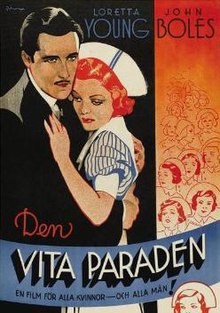The White Parade
| The White Parade | |
|---|---|
 Swedish Theatrical release poster | |
| Directed by | Irving Cummings |
| Written by | Rian James (novel)/(screenplay) Jesse L. Lasky Jr. Sonya Levien Ernest Pascal |
| Produced by | Jesse L. Lasky |
| Starring | Loretta Young John Boles |
| Cinematography | Arthur C. Miller |
| Music by | Louis De Francesco |
| Distributed by | Fox Film Corporation |
Release date |
|
Running time | 80 minutes |
| Country | United States |
| Language | English |
The White Parade is a 1934 film directed by Irving Cummings and starring Loretta Young and John Boles. It was written by Rian James, Jesse Lasky Jr., Sonya Levien and Ernest Pascal, from the novel by Rian James.
Dedicated to "the memory of Florence Nightingale", the plot concerns the travails and romances of young women as they study to become nurses. The film was nominated for the Academy Award for Best Picture.
The only surviving print is located at the UCLA film archive. The print is in rough shape; several frames are out of alignment, at times, while the whole picture looks bleached out and very fuzzy. As well, near the end of the film, a sign pops up indicating "reel 7".
Plot
This article needs a plot summary. (December 2023) |
Cast
- Loretta Young as June Arden
- John Boles as Ronald Hall III
- Dorothy Wilson as Zita Scofield
- Muriel Kirkland as Glenda Farley
- Astrid Allwyn as Gertrude Mack
- Frank Conroy as Dr. Thorne
- Jane Darwell as Miss 'Sailor' Roberts
- Sara Haden as Miss Harrington
- Joyce Compton as Una Mellon
- June Gittelson as Lou 'Pudgy' Stebbins
- Polly Ann Young as Hannah Seymour
- Noel Francis as Nurse Clare
- Shirley Palmer as Telephone Operator
Reception
The film was a success at the box office.[1]
Awards
The White Parade was nominated for the Best Picture Oscar in 1934. Loretta Young also appeared in The House of Rothschild the same year, which was also nominated for the Academy Award for Best Picture.[2] The film was also nominated in the category Sound Recording (Edmund H. Hansen).
References
- ^ Churchill, Douglas W. The Year in Hollywood: 1934 May Be Remembered as the Beginning of the Sweetness-and-Light Era (gate locked); New York Times 30 Dec 1934: X5. Retrieved December 16, 2013.
- ^ "The 7th Academy Awards (1935) Nominees and Winners". oscars.org. Retrieved 2011-08-07.